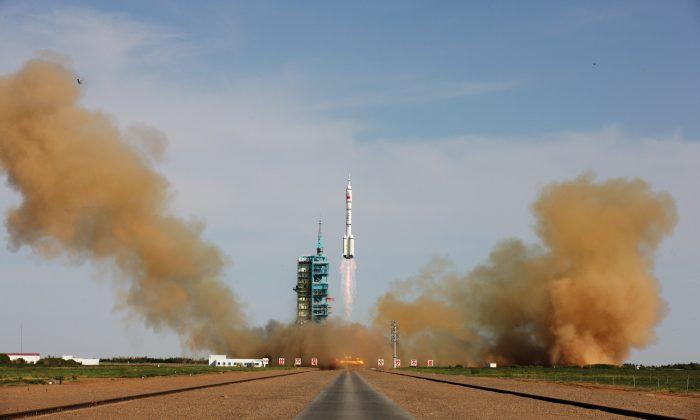New arenas of warfare are opening up. The U.S. military is already heavily reliant on satellites and communication systems, and countries like China are actively trying to undermine these systems.
“There’s not an operation conducted anywhere at any level that is not somehow dependent on space and cyberspace,” said General William L. Shelton, Commander of the Air Force Space Command at Peterson Air Force Base in Colorado, on Sept. 21, according to the Department of Defense.
Yet amid the proliferation of space and cyberspace in the military, the next challenge is to get all troops linked in and secure those connections.
Shelton said the United States is facing four key threats: jamming, lasers, attacks on ground sites, and nuclear detonations in space.
He said the dangers these technologies pose to the U.S. military need to be recognized, noting “We can’t continue, in my mind, to operate with this big-sky mentality.”
The four key threats he mentioned are also four key capabilities the Chinese regime is developing.
Documents released through WikiLeaks show strong tensions between the United States and China over weaponry for space warfare.
On Jan. 11, 2007, China destroyed one of its own satellites using a ground-based anti-satellite (ASAT) weapon. A WikiLeaks document of State Department cables says the test was done without warning and China gave “no sensible answer” to any nation that approached it afterward.
The test also filled a lower orbit with an estimated 2,500 pieces of dangerous debris. The WikiLeaks document says the United States told China clearly that “The United States reserves the right, consistent with the UN Charter and international law, to defend and protect its space systems with a wide range of options, from diplomatic to military.”
The test raised concerns that China is developing space warfare systems despite claiming otherwise. The cable states that the U.S. stopped space-relation cooperation with China, and “One of the primary reasons for this position is the continued lack of transparency from China regarding the full range of China’s space activities.”
Countries have been forced to track and avoid the debris with satellites and other space equipment. In May this year, debris from China’s 2007 test struck and destroyed a Russian satellite.
A State Department cable states that on Jan. 11, 2010, China launched a missile that intercepted a medium-range ballistic missile launched at almost the same time from the Shuangchengzi Space and Missile Center.
The cable stated the missile used was the same type China used during its 2007 ASAT test, and “This test is assessed to have furthered both Chinese ASAT and ballistic missile defense (BMD) technologies.”
While China makes as much noise as possible around its development of a fifth-generation fighter jet and its Navy, it is silent about space warfare and has even tried covering up tests.
In May, when China launched a new Dong Ning-2 anti-satellite missile, it tried telling the public it was the Chinese Academy of Scienes experimenting with a sounding rocket, according to military news website Alert5.
China’s development of weapons targeted at space and cyber are part of its anti-access strategy, which was outlined by Roger Cliff of the RAND Corporation, during a January 2011 testimony before the U.S.-China Economic and Security Review Commission.
Cliff said the strategy aims to disable a technologically superior military by striking the critical systems that enable the technology. He said, “This concept is based on the idea that, rather than attempting to destroy an adversary’s entire military force, the PLA should try to paralyze the adversary by attacking critical nodes in its system of systems.”
China classifies its space and cyber weapons under its shadowy “Assassin’s Mace” or “Trump Card” (Sha Shou Jian) weapons, according to a declassified but heavily redacted report, “China: Medical Research on Bio-Effects of Electromagnetic Pulse and High-Power Microwave Radiation.”
It states the weapons were designed to “Permit China to prevail over the United States in a conflict over a forced reunification with Taiwan.” They include, among other systems, detonating nuclear weapons in high altitude to fry electronics with an electromagnetic pulse.
During the February 2012 annual threat assessment, Lt. Gen. Ronald L. Burgess, director of the U.S. Defense Intelligence Agency, warned of China’s growing focus on space warfare.
Burgess said China’s public space programs support its ability to harm space systems of other nations and feed China’s military capabilities. He said, “Beijing rarely acknowledges direct military applications of its space program and refers to nearly all satellite launches as scientific or civil in nature.”
He said in addition to anti-satellite missiles, China is also “developing jammers and directed-energy weapons for ASAT missions.”
Despite China’s claims to a $93 billion military budget, the United States believes the true budget is as much as $183 billion, Burgess said.


![[LIVE Q&A 04/18 at 10:30AM ET] 20 States Want to Allow Assisted Suicide](/_next/image?url=https%3A%2F%2Fimg.theepochtimes.com%2Fassets%2Fuploads%2F2024%2F04%2F17%2Fid5631798-CR-TN_REC_0418-1080x720.jpg&w=1200&q=75)



Friends Read Free